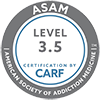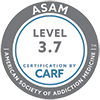While most people assume substance abuse and addiction are problems only young people deal with, that is not actually the case.
Substance use disorders and dependencies can develop and be harmful at any age.
Adults of advanced age have unique issues and risk factors to consider. As the number of aches and pains grows, the desire to find a relief grows also. Older patients citing chronic conditions such as arthritis, degenerative discs, migraine headaches, or even cancer and neurological issues are prescribed opioids for pain management, but very few understand how to handle them to reduce the risk of addiction.
In this post, we outline the most important safety concerns for seniors using opioid medication to manage their pain.
1. Seniors Aren’t Informed of Medication Risk
This singular issue could be considered the reason behind the other five on this list. Everything really boils down to information – and the lack thereof. Elderly patients especially are not always given all the information they need to be informed about the medications they are prescribed. This is dangerous when dealing with addictive substances such as opioids.
When patients are unaware of side effects and addiction warning signs to look for, they can easily be missed. The opioids can interfere with or adversely interact with other medications and cause catastrophic consequences.
There are many ways to get information and become informed via technology, but not many seniors have the skills necessary to access the information they need to stay safe. Most people want to think their physicians are looking out for them and will discuss everything important to know before prescribing a medication.
2. Opioids Are Over- and Unnecessarily Prescribed
This issue is also a cause for others on this list. As people age, different problems occur. Aches and pains become more plentiful. Injuries or surgeries have longer recovery times. Many people think that a prescription pain medication will be more effective or stronger than things purchased over-the-counter. While this can be true, the list of problems those medications can cause in exchange are lengthy.
For this reason, opioids are not considered effective for long-term or chronic conditions. Opioids should be taken for as little time as possible, preferably for three days or less. After only five days of typical dosage, a person can begin to build a physical dependence. A survey in 2016 found 99 percent of doctors exceed this time limit when prescribing opioids.
3. Hospital Admissions Can Be Due to Opioid Side Effects
Since opioids can cause drowsiness and disorientation, the risk of falls or other injury increases dramatically. In a demographic who are already at an increased risk for other problems developing as a result after injury, this is especially alarming. Seniors who take prescribed opioids are four to five times more likely to fall and/or suffer a fracture than seniors who are taking non-opioid medications for pain management.
Other common side effects of opioids include confusion, constipation, and breathing problems. A September 2018-released study by the Agency for Healthcare Research and Quality (AHRQ) shows the drastic numbers of inpatient and emergency department admissions for patients aged 65 and older that used opioids as opposed to those who did not.
Between 2010 and 2015, the number of opioid-related inpatient stays by seniors rose 34.3 percent while non-opioid-related stays decreased 17.4 percent. In the same time period, there was a 74.2 percent increase in the amount of opioid-related emergency department visits while there was only a 17.4 percent increase in non-opioid-related ED visits.
4. Seniors May Accidentally Overdose
This issue can have multiple causes, though all are avoidable. Elderly patients can easily overdose by forgetting if they have taken the medication and inadvertently doubling or tripling their dosing. Misreading the instructions is also a possibility, especially if the person is already in an altered state of confusion from the opioid’s side effects.
There is also a significant chance for overuse of opioids due to tolerance. When taken for a longer period of time than recommended, the body develops a tolerance to the medication and thus it takes more (or more frequent) doses to maintain pain management. Not keeping an accurate schedule of dosage times and amounts can inadvertently cause overuse and raise the chances for side effects.
5. The Risk of Medication Interactions Rises with Age
With advanced age comes the potential for more medical problems. This means more medications are being used to treat age-related ailments.
Drug interactions are a potentially serious challenge for seniors. Many times, there are multiple prescribing doctors, including hospital staff, family physicians, urgent care/ED doctors, and specialists.
While every attempt to keep medication lists current is made by each clinic staff, if dosages change or if the patient forgets to tell of a new medication at an appointment elsewhere, a medication could be prescribed that interacts. Some interactions between medications can be extremely dangerous and could even lead to medical events that cause permanent damage.
6. Seniors Have a High Risk of Undiagnosed Addiction and Misattributed Overdose Deaths
Opioid addiction is generally noticed by a relative or friend in the case of elderly patients. However, even observers closest to the person abusing their medications can write off certain symptoms instead of seeing them as red flags for addiction.
These caring friends and family members tend to believe that their loved one is just showing natural signs of aging when there are increased instances of imbalance or mental fog. When the patient seems overly-attentive to their medication schedule or eager to be sure they have extra pills on hand, loved ones write this off as wanting to be prepared for pain management.
When people stop taking opioids after becoming physically dependent on them, the withdrawal feelings can be overwhelming and awful. Because they feel badly, they take their medication. When the symptoms disappear, they assume it’s because the drug is relieving their condition. Instead, it is merely relieving the pain and discomfort associated with opioid withdrawal.
Overdose deaths by senior citizens often go unreported or unnoticed. It isn’t unusual for elderly patients to pass suddenly from natural causes, so autopsies aren’t performed as often in these cases and no cause of death is determined. This means the opioid epidemic statistics surrounding seniors and overdose/interaction deaths are not accurately represented.
Staying Safe and Knowing When to Get Help
Elderly patients with chronic pain conditions should educate themselves on the potential problems and side effects of the opioids they are prescribed. They also need to be aware that opioids are not a suitable choice for chronic pain. If addiction does develop, St. Gregory Recovery Center’s substance abuse treatment programs can provide the necessary care.







